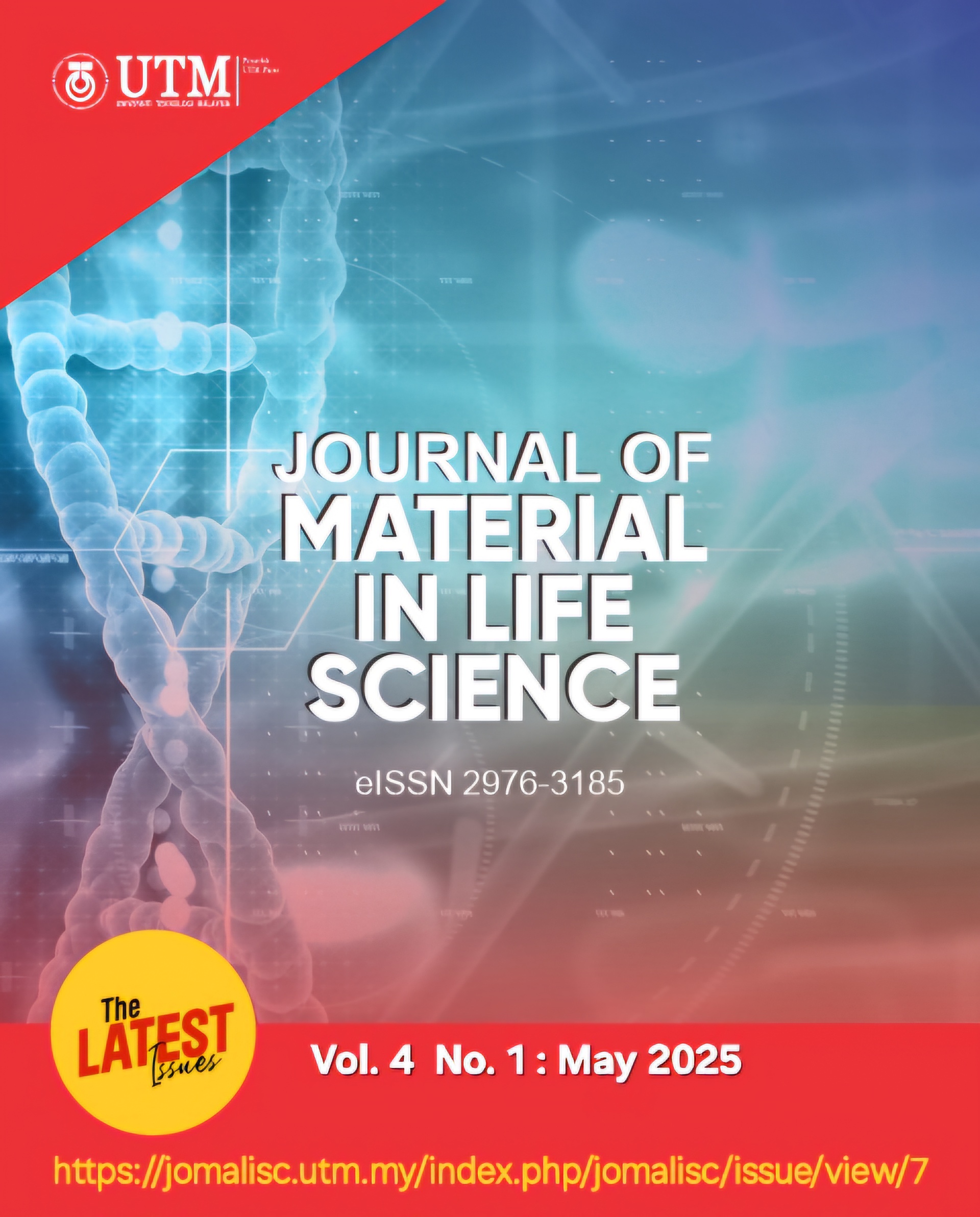Polynomial-Optimized Calcination of TiO₂-Based Photoanodes for Enhanced Photocurrent in Solar Hydrogen Production: Integrating Data Science with Functional Design
DOI:
https://doi.org/10.11113/jomalisc.v4.86Keywords:
titanium dioxide, polynomial fitting, bimetallic photoanodes, hydrogen production, water splittingAbstract
The calcination temperature of metal oxide semiconductors plays a pivotal role in dictating their crystallinity, phase purity, and charge transport behavior, all of which are critical to enhancing photoelectrochemical (PEC) water splitting. In this study, we apply a fifth-order polynomial curve fitting model to analyze and optimize the calcination temperature of various n-type semiconductors, ultimately identifying 550 °C as the first-layer calcination temperature for titanium dioxide (TiO₂) photoanodes. Based on this data-driven insight, bimetallic oxide composites of ZnO/TiO₂ (1:2) and MnO₂/TiO₂ (1:2) were synthesized via solid-state mixing followed by thermal treatment at the polynomial-predicted temperature. X-ray diffraction (XRD) analyses confirmed the formation of tetragonal anatase TiO₂, hexagonal wurtzite ZnO, and β-MnO₂ crystalline phases in their respective composites. Structural refinement revealed an increase in crystallite size and d-spacing shifts, indicative of heterojunction formation. Photoelectrochemical measurements under simulated sunlight revealed that MnO₂/TiO₂ (1:2) exhibited the highest photocurrent density (0.02052 A cm⁻²), outperforming pristine TiO₂ and ZnO/TiO₂ (1:2) composites. Electrochemical impedance spectroscopy (EIS) further demonstrated a reduced charge transfer resistance in MnO₂/TiO₂ (9.76 Ω), supporting its superior PEC performance. This work demonstrates a successful integration of predictive modelling with materials synthesis, offering a rational and reproducible pathway for optimizing thermally treated photoanodes for solar-driven hydrogen generation
References
Jang, Y. J., Kim, H. G., & Choi, W. (2016). Revisiting the Role of Photogenerated Charge Carriers in Heterogeneous Photocatalysis: A Perspective Based on Ultrahigh-Resolution Photoemission and Transient Absorption Spectroscopies. Chemical Society Reviews, 45(12), 3015–3034. https://doi.org/10.1039/C5CS00848F
Xu, Y., Zhang, X., Li, Q., & Liu, S. (2021). Advances in Bandgap Engineering of TiO₂-Based Materials for Enhanced Photoelectrochemical Water Splitting. Applied Surface Science, 558, 149979. https://doi.org/10.1016/j.apsusc.2021.149979
Thabet, N., Ahmed, A., & Yusof, M. (2024). Enhanced Photoelectrochemical Hydrogen Production via Transition Metal Co-Catalyst Decorated TiO₂ Nanostructures. Scientific Reports, Nature, 14(1), Article 11234. https://doi.org/10.1038/s41598-024-11234-x
Jiang, C., Moniz, S. J. A., Wang, A., Zhang, T., & Tang, J. (2016). Photoelectrochemical Devices for Solar Water Splitting – Materials and Challenges. Chemical Society Reviews, 46(15), 4645–4660. https://doi.org/10.1039/C6CS00306K
Wang, Y., Zhang, K., Wang, X., Liu, Q., & Zhang, L. (2021). Calcination Temperature Dependent Photocatalytic Activity and Physicochemical Properties of TiO₂ Nanoparticles. Materials Science in Semiconductor Processing, 131, 105830. https://doi.org/10.1016/j.mssp.2021.105830
Oral, B., Can, E., & Yildirim, R. (2022). Analysis of photoelectrochemical water splitting using machine learning. International Journal of Hydrogen Energy, 47(45), 19633–19654. https://doi.org/10.1016/j.ijhydene.2022.01.011
Sun, Y., Wang, Y., Li, Y., Zhang, X., & Liu, H. (2020). One-step Hydrothermal Preparation and Characterization of ZnO–TiO₂ Nanocomposites for Photocatalytic Activity. Materials Research Express, 7(9), 095004. https://doi.org/10.1088/2053-1591/abaea4
Alonizan, N., Rabaoui, S., Omri, K., & Qindeel, R. (2018). Microstructure and Luminescence Properties of ZnO:Mn Nanoparticles and ZnO:Mn/TiO₂ Nanocomposite Synthesized by A Two-Step Chemical Method. Applied Physics A, 124(9), 710. https://doi.org/10.1007/s00339-018-2127-y
Lai, M. T. L., Lee, K. M., Yang, T. C. K., Lai, C. W., Chen, C.-Y., Johan, M. R., & Juan, J. C. (2023). Highly Effective Interlayer Expanded MoS2 Coupled with Bi2WO6 as P-N Heterojunction Photocatalyst for Photodegradation of Organic Dye Under LED White Light. Journal of Alloys and Compounds, 953. https://doi.org/10.1016/j.jallcom.2023.169834
Manna, S., Satpati, A. K., Patra, C. N., & Tyagi, A. K. (202). Enhancing the PEC Eefficiency in the Perspective of Crystal Facet Engineering and Modulation of Surfaces. ACS Omega, 9(6), 6128–6146. https://doi.org/10.1021/acsomega.3c07867
Liu, S., Tang, Y., Guo, C., Liu, Y., & Tang, Z. (2023). Heterostructure of NiFe@NiCr-LDH for Active and Durable Oxygen Evolution Reactions in Alkaline Media. Materials, 16(8), 2968. https://doi.org/10.3390/ma16082968
Medhi, R., Marquez, M. D., & Lee, T. R. (2020). Visible-light-active Doped Metal Oxide Nanoparticles: Review of Their Synthesis, Properties, and Applications. ACS Applied Nano Materials, 3(7), 6156–6185. https://doi/abs/10.1021/acsanm.0c01035
Abdelfattah I & El-Shamy AM (2024). A Comparative Study for Optimizing Photocatalytic Activity of TiO2-based Composites with ZrO2, ZnO, Ta2O5, SnO, Fe2O3, and CuO Additives. Scientific Reports. 14(1):27175. https://www.nature.com/articles/s41598-024-77752-5
Das, A., Liu, D., Wu, Y., Abzakh, B. A., Kazakova, E. A., Vasenko, A. S., & Prezhdo, O. V. (2024). Origin of the Improved Photoelectrochemical and Photocatalytic Activity in a ZnO-TiO2 Nanohybrid Revealed by Experimental and Density Functional Theory Studies. The Journal of Physical Chemistry Letters, 15(29), 7524-7532. https://doi/full/10.1021/acs.jpclett.4c01641
Taneja, Y., Dube, D., & Singh, R. (2024). Recent Advances in Elemental Doping and Simulation Techniques:Improving Structural, Photophysical and Electronic Properties of Titanium Oxide. Journal of Materials Chemistry C. 12, 14774-14808.https://doi.org/10.1039/D4TC02031F


















